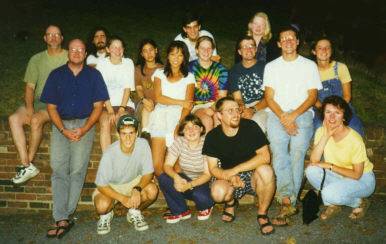|
Section I—Introduction and Project Summary
At the Conservation and Research Center near Front
Royal, Virginia, Bill McShea and his staff are studying the effect of
white-tailed deer on other animals within their forest community. At different
times of the year, they look at small mammals, forest birds, understory plants,
that is those found within six meters of the forest floor, acorns, and deer to
determine how these diverse organisms interact and to understand the
ramifications of deer density throughout the forest community. The central
research question is this: do present densities of deer prevent the proper
management of other threatened or endangered species within protected areas?
Work is conducted in Virginia’s Blue Ridge Mountains, Shenandoah Valley,
George Washington National Forest, Shenandoah National Park, and the National
Zoo’s Conservation and Research Center.
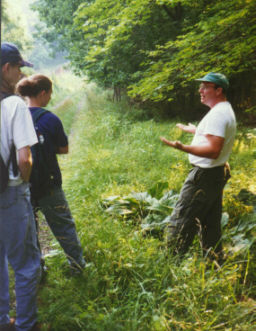 The following methods are used. The deer are fenced out
of certain areas through the use of what Bill McShea calls "exclosures"
and are allowed to roam freely in the control areas. In these areas, deer are
tracked, small mammals are trapped, acorns are collected, birds are caught
through the use of mist nets, and vegetation is sampled to determine density and
diversity of forest understory and ground cover. Because of the increasing
awareness of the relationship among the various organisms and the resultant web
of life, many elements must be studied. Specifically, data is recorded in many
ways. Deer location is noted on topographic maps and then transferred to a
computer data base. Acorn fall is graphed by month and by year. Small mammals
are weighed, measured, sexed, and the exact location is noted. Twenty scarlet
tanagers were captured, tagged, and released. A grid map is used to plot the
location of understory plants in the vegetation studies. Global Positioning
System (GPS) is used in all aspects of the project. The following methods are used. The deer are fenced out
of certain areas through the use of what Bill McShea calls "exclosures"
and are allowed to roam freely in the control areas. In these areas, deer are
tracked, small mammals are trapped, acorns are collected, birds are caught
through the use of mist nets, and vegetation is sampled to determine density and
diversity of forest understory and ground cover. Because of the increasing
awareness of the relationship among the various organisms and the resultant web
of life, many elements must be studied. Specifically, data is recorded in many
ways. Deer location is noted on topographic maps and then transferred to a
computer data base. Acorn fall is graphed by month and by year. Small mammals
are weighed, measured, sexed, and the exact location is noted. Twenty scarlet
tanagers were captured, tagged, and released. A grid map is used to plot the
location of understory plants in the vegetation studies. Global Positioning
System (GPS) is used in all aspects of the project.
How could such a project be of value to a third-grade
teacher in a self-contained classroom? There are many applications for a project
such as this. I will focus on three of them.
- The first would be to study how field research is
conducted and to apply this to a schoolyard learning experience. A direct study
of nature involves hands-on learning. No amount of book learning, videos, or
explanations can substitute for field work done with the objective of answering
questions. Equally important are the questions students raise.
- The second possible application of this Earthwatch
project would be to provide a real-world use of such things as mathematics,
scientific observation and record-keeping, use of communication skills, and art.
- The third and possibly most important application of
this would be to infuse the learning process with excitement and wonder. Seeing
a red-winged blackbird for the first time, for example, is something that is
meaningful and worth the time invested. Perhaps, doing field work on a smaller
scale as a part of the curriculum will lead students to see the importance of
the natural world in their lives and spark life-long interest in this area.
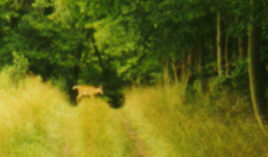 To summarize, a project of this complexity has enormous
potential for me as a teacher. I can bring the world of the research biologist
to the schoolyard. This has many uses in today’s overlapping curriculum. I can
combine many areas of the curriculum — language arts, math, science, art, and
technology — and avoid fragmented lessons that are soon forgotten, replacing
them with exciting, hands-on lessons that will be help children make sense of
their world. To summarize, a project of this complexity has enormous
potential for me as a teacher. I can bring the world of the research biologist
to the schoolyard. This has many uses in today’s overlapping curriculum. I can
combine many areas of the curriculum — language arts, math, science, art, and
technology — and avoid fragmented lessons that are soon forgotten, replacing
them with exciting, hands-on lessons that will be help children make sense of
their world.
|
Section II—Experiences and Ideas
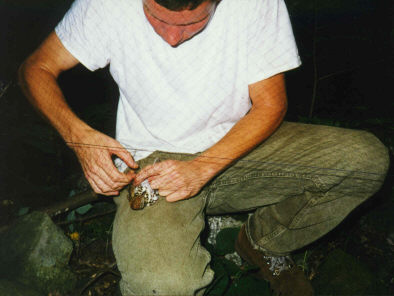 Participating in Shenandoah Wildlife was a real
learning experience. For many years, I have fancied myself as a student of
nature. I love to hike, observe birds, flowers, and trees, and learn new things.
This experience was unique in that it made me see how all these things work
together in an ecosystem. In our introductory lecture/hike through the research
center, we learned about the trees that provided canopy—oak, hickory, and
tulip poplar, as well as the understory plants — sassafras, skunkweed, spice
bush, and paw paw. This led to a discussion of the deer in the area as we
observed the browse line and the plants they fed on in the understory. Although
many types of trees were pointed out and identifying characteristics were made
clear, the image of the forest as a complex system began to emerge, and I will
never again be able to look at anything in the forest as an isolated entity.
Thus, my education was begun in ecological thinking that would span the two
weeks of my Earthwatch experience and forever change my view of the natural
world. Participating in Shenandoah Wildlife was a real
learning experience. For many years, I have fancied myself as a student of
nature. I love to hike, observe birds, flowers, and trees, and learn new things.
This experience was unique in that it made me see how all these things work
together in an ecosystem. In our introductory lecture/hike through the research
center, we learned about the trees that provided canopy—oak, hickory, and
tulip poplar, as well as the understory plants — sassafras, skunkweed, spice
bush, and paw paw. This led to a discussion of the deer in the area as we
observed the browse line and the plants they fed on in the understory. Although
many types of trees were pointed out and identifying characteristics were made
clear, the image of the forest as a complex system began to emerge, and I will
never again be able to look at anything in the forest as an isolated entity.
Thus, my education was begun in ecological thinking that would span the two
weeks of my Earthwatch experience and forever change my view of the natural
world.
From an historical perspective, we were walking on
ground that George Washington, himself, surveyed. The land was also used as by
the US Army as a cavalry station for their horses. Much of the land is mowed and
is still looks like meadowland. The land is now owned by the National Zoological
Park and the Smithsonian Institution and is the home to many endangered species
from around the world, such as the crowned crane, Pere David’s deer, and the
scimitar-horned oryx. A tour of the center by van allowed us to see animals from
around the world that people cared about and brought to Virginia to save. I felt
that there was a certain prestige associated with this place.
During the two weeks, we also heard a lecture by the
Nature Conservancy of Virginia, and this emphasized how people can be connected
to the environment in very real ways and showed the commitment of people who
believe in saving places as well as conducting research that will further the
understanding of the environment. Another lecture by Bill McShea, focused on
his study and examined the results so far. Complete with charts and graphs, this
was not the definitive "answer" to all the questions he had as the
Principal Investigator. Rather, each question served more to raise a new
question or to interject a new variable. On another occasion, Bill showed us his
slides of Burma (Myanmar) and the work he initiated there saving the Eld’s
deer. This is a fascinating subject and full of the complexities of politics,
Eastern culture, third-world poverty, and Western thinking. But, yet again, it
showed us the effects of the environment on how people live and the effects of
caring or not caring for the world around us.
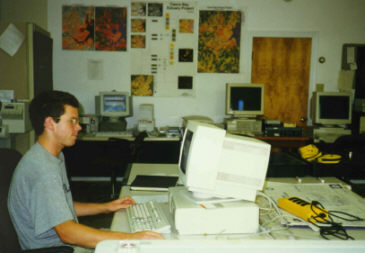 Our days were busy with many activities. They
included early morning mist-netting in search of the elusive scarlet tanager,
deer tracking, vegetation recording, work at the GIS (Geographic Information
Systems) computer lab, and maintenance of the fences on the exclosures. The
hardest work, however, is done at George Washington National Forest, three hours
to the west of Front Royal. There, I was to test my mettle. A small group is
taken out there at a time to help Liz and John who stay at the A-frame for
months and trap mammals on a daily basis. To the uninitiated, this work is quite
a shock. The terrain is not the rolling hills of Front Royal, which some may
think of as already quite challenging. These are real mountains, and to get to
where the traps are placed (sites selected by computer), you must traverse
rugged terrain. We walked through rocky stream beds, crawled over logs, pulled Our days were busy with many activities. They
included early morning mist-netting in search of the elusive scarlet tanager,
deer tracking, vegetation recording, work at the GIS (Geographic Information
Systems) computer lab, and maintenance of the fences on the exclosures. The
hardest work, however, is done at George Washington National Forest, three hours
to the west of Front Royal. There, I was to test my mettle. A small group is
taken out there at a time to help Liz and John who stay at the A-frame for
months and trap mammals on a daily basis. To the uninitiated, this work is quite
a shock. The terrain is not the rolling hills of Front Royal, which some may
think of as already quite challenging. These are real mountains, and to get to
where the traps are placed (sites selected by computer), you must traverse
rugged terrain. We walked through rocky stream beds, crawled over logs, pulled 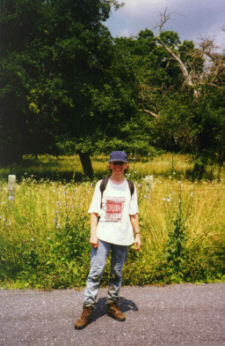 ourselves up hill by trees and roots, slipped on rocks and mud, grabbed saplings
as we lost control running downhill, and fell through deep leaf litter onto
rocks and logs underneath. At the end of the first day, filthy and sore, I knew
I had survived a rough experience, but I was glad to have done it. The second
day involved setting the traps put out the day before, but I was with another
person who moved more like I did through the woods and perhaps understood that I
was not as young as they were and so I managed better, the terrain being easier
too. Our last day in the Allegheny Mountains was also the third day in the
trapping cycle—we checked the traps and found deer mice, white-footed mice and
shrews. These were weighed, measured, sexed, and tagged in case of a recapture.
The data was recorded, since that’s what feeds a field report, a valuable
lesson for a teacher contemplating schoolyard field research. We returned to
Front Royal in the afternoon, dirty, hot, and tired, but very much more
knowledgeable about ourselves and more aware of the dedication that field
work in biology requires.
ourselves up hill by trees and roots, slipped on rocks and mud, grabbed saplings
as we lost control running downhill, and fell through deep leaf litter onto
rocks and logs underneath. At the end of the first day, filthy and sore, I knew
I had survived a rough experience, but I was glad to have done it. The second
day involved setting the traps put out the day before, but I was with another
person who moved more like I did through the woods and perhaps understood that I
was not as young as they were and so I managed better, the terrain being easier
too. Our last day in the Allegheny Mountains was also the third day in the
trapping cycle—we checked the traps and found deer mice, white-footed mice and
shrews. These were weighed, measured, sexed, and tagged in case of a recapture.
The data was recorded, since that’s what feeds a field report, a valuable
lesson for a teacher contemplating schoolyard field research. We returned to
Front Royal in the afternoon, dirty, hot, and tired, but very much more
knowledgeable about ourselves and more aware of the dedication that field
work in biology requires.
Teachers, as well as researchers, must be
concerned with the scientific method, working with the community, and team work.
From these experiences, I
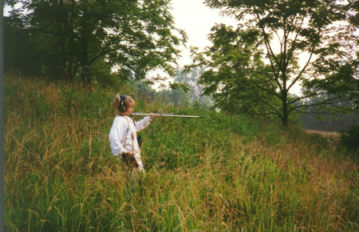 have a much better understanding of how scientists
obtain their data. I feel that students at a very early age can also learn to
observe, record, and compare data. So, these methods will be carried over into
my own teaching. While talking to Liz, the coordinator of the Allegheny project,
she told me that she had to contact many landowners in the valley to get
permission to cross their land in order to gain access to the national forest.
This shows cooperation with the community in order to conduct scientific
research. Teachers, too, must work with the local community on various projects,
such as bringing in resource people or using facilities. Another component of
the Earthwatch experience is teamwork; each person has their expertise and
responsibilities. People depend on each other to get the job done. Children,
too, must learn teamwork at an early age. A project involving field research
needs the cooperation of each individual; there are many ways this work can be
divided. have a much better understanding of how scientists
obtain their data. I feel that students at a very early age can also learn to
observe, record, and compare data. So, these methods will be carried over into
my own teaching. While talking to Liz, the coordinator of the Allegheny project,
she told me that she had to contact many landowners in the valley to get
permission to cross their land in order to gain access to the national forest.
This shows cooperation with the community in order to conduct scientific
research. Teachers, too, must work with the local community on various projects,
such as bringing in resource people or using facilities. Another component of
the Earthwatch experience is teamwork; each person has their expertise and
responsibilities. People depend on each other to get the job done. Children,
too, must learn teamwork at an early age. A project involving field research
needs the cooperation of each individual; there are many ways this work can be
divided. |
 The following methods are used. The deer are fenced out
of certain areas through the use of what Bill McShea calls "exclosures"
and are allowed to roam freely in the control areas. In these areas, deer are
tracked, small mammals are trapped, acorns are collected, birds are caught
through the use of mist nets, and vegetation is sampled to determine density and
diversity of forest understory and ground cover. Because of the increasing
awareness of the relationship among the various organisms and the resultant web
of life, many elements must be studied. Specifically, data is recorded in many
ways. Deer location is noted on topographic maps and then transferred to a
computer data base. Acorn fall is graphed by month and by year. Small mammals
are weighed, measured, sexed, and the exact location is noted. Twenty scarlet
tanagers were captured, tagged, and released. A grid map is used to plot the
location of understory plants in the vegetation studies. Global Positioning
System (GPS) is used in all aspects of the project.
The following methods are used. The deer are fenced out
of certain areas through the use of what Bill McShea calls "exclosures"
and are allowed to roam freely in the control areas. In these areas, deer are
tracked, small mammals are trapped, acorns are collected, birds are caught
through the use of mist nets, and vegetation is sampled to determine density and
diversity of forest understory and ground cover. Because of the increasing
awareness of the relationship among the various organisms and the resultant web
of life, many elements must be studied. Specifically, data is recorded in many
ways. Deer location is noted on topographic maps and then transferred to a
computer data base. Acorn fall is graphed by month and by year. Small mammals
are weighed, measured, sexed, and the exact location is noted. Twenty scarlet
tanagers were captured, tagged, and released. A grid map is used to plot the
location of understory plants in the vegetation studies. Global Positioning
System (GPS) is used in all aspects of the project. To summarize, a project of this complexity has enormous
potential for me as a teacher. I can bring the world of the research biologist
to the schoolyard. This has many uses in today’s overlapping curriculum. I can
combine many areas of the curriculum — language arts, math, science, art, and
technology — and avoid fragmented lessons that are soon forgotten, replacing
them with exciting, hands-on lessons that will be help children make sense of
their world.
To summarize, a project of this complexity has enormous
potential for me as a teacher. I can bring the world of the research biologist
to the schoolyard. This has many uses in today’s overlapping curriculum. I can
combine many areas of the curriculum — language arts, math, science, art, and
technology — and avoid fragmented lessons that are soon forgotten, replacing
them with exciting, hands-on lessons that will be help children make sense of
their world. Participating in Shenandoah Wildlife was a real
learning experience. For many years, I have fancied myself as a student of
nature. I love to hike, observe birds, flowers, and trees, and learn new things.
This experience was unique in that it made me see how all these things work
together in an ecosystem. In our introductory lecture/hike through the research
center, we learned about the trees that provided canopy—oak, hickory, and
tulip poplar, as well as the understory plants — sassafras, skunkweed, spice
bush, and paw paw. This led to a discussion of the deer in the area as we
observed the browse line and the plants they fed on in the understory. Although
many types of trees were pointed out and identifying characteristics were made
clear, the image of the forest as a complex system began to emerge, and I will
never again be able to look at anything in the forest as an isolated entity.
Thus, my education was begun in ecological thinking that would span the two
weeks of my Earthwatch experience and forever change my view of the natural
world.
Participating in Shenandoah Wildlife was a real
learning experience. For many years, I have fancied myself as a student of
nature. I love to hike, observe birds, flowers, and trees, and learn new things.
This experience was unique in that it made me see how all these things work
together in an ecosystem. In our introductory lecture/hike through the research
center, we learned about the trees that provided canopy—oak, hickory, and
tulip poplar, as well as the understory plants — sassafras, skunkweed, spice
bush, and paw paw. This led to a discussion of the deer in the area as we
observed the browse line and the plants they fed on in the understory. Although
many types of trees were pointed out and identifying characteristics were made
clear, the image of the forest as a complex system began to emerge, and I will
never again be able to look at anything in the forest as an isolated entity.
Thus, my education was begun in ecological thinking that would span the two
weeks of my Earthwatch experience and forever change my view of the natural
world. Our days were busy with many activities. They
included early morning mist-netting in search of the elusive scarlet tanager,
deer tracking, vegetation recording, work at the GIS (Geographic Information
Systems) computer lab, and maintenance of the fences on the exclosures. The
hardest work, however, is done at George Washington National Forest, three hours
to the west of Front Royal. There, I was to test my mettle. A small group is
taken out there at a time to help Liz and John who stay at the A-frame for
months and trap mammals on a daily basis. To the uninitiated, this work is quite
a shock. The terrain is not the rolling hills of Front Royal, which some may
think of as already quite challenging. These are real mountains, and to get to
where the traps are placed (sites selected by computer), you must traverse
rugged terrain. We walked through rocky stream beds, crawled over logs, pulled
Our days were busy with many activities. They
included early morning mist-netting in search of the elusive scarlet tanager,
deer tracking, vegetation recording, work at the GIS (Geographic Information
Systems) computer lab, and maintenance of the fences on the exclosures. The
hardest work, however, is done at George Washington National Forest, three hours
to the west of Front Royal. There, I was to test my mettle. A small group is
taken out there at a time to help Liz and John who stay at the A-frame for
months and trap mammals on a daily basis. To the uninitiated, this work is quite
a shock. The terrain is not the rolling hills of Front Royal, which some may
think of as already quite challenging. These are real mountains, and to get to
where the traps are placed (sites selected by computer), you must traverse
rugged terrain. We walked through rocky stream beds, crawled over logs, pulled  ourselves up hill by trees and roots, slipped on rocks and mud, grabbed saplings
as we lost control running downhill, and fell through deep leaf litter onto
rocks and logs underneath. At the end of the first day, filthy and sore, I knew
I had survived a rough experience, but I was glad to have done it. The second
day involved setting the traps put out the day before, but I was with another
person who moved more like I did through the woods and perhaps understood that I
was not as young as they were and so I managed better, the terrain being easier
too. Our last day in the Allegheny Mountains was also the third day in the
trapping cycle—we checked the traps and found deer mice, white-footed mice and
shrews. These were weighed, measured, sexed, and tagged in case of a recapture.
The data was recorded, since that’s what feeds a field report, a valuable
lesson for a teacher contemplating schoolyard field research. We returned to
Front Royal in the afternoon, dirty, hot, and tired, but very much more
knowledgeable about ourselves and more aware of the dedication that field
work in biology requires.
ourselves up hill by trees and roots, slipped on rocks and mud, grabbed saplings
as we lost control running downhill, and fell through deep leaf litter onto
rocks and logs underneath. At the end of the first day, filthy and sore, I knew
I had survived a rough experience, but I was glad to have done it. The second
day involved setting the traps put out the day before, but I was with another
person who moved more like I did through the woods and perhaps understood that I
was not as young as they were and so I managed better, the terrain being easier
too. Our last day in the Allegheny Mountains was also the third day in the
trapping cycle—we checked the traps and found deer mice, white-footed mice and
shrews. These were weighed, measured, sexed, and tagged in case of a recapture.
The data was recorded, since that’s what feeds a field report, a valuable
lesson for a teacher contemplating schoolyard field research. We returned to
Front Royal in the afternoon, dirty, hot, and tired, but very much more
knowledgeable about ourselves and more aware of the dedication that field
work in biology requires.
 have a much better understanding of how scientists
obtain their data. I feel that students at a very early age can also learn to
observe, record, and compare data. So, these methods will be carried over into
my own teaching. While talking to Liz, the coordinator of the Allegheny project,
she told me that she had to contact many landowners in the valley to get
permission to cross their land in order to gain access to the national forest.
This shows cooperation with the community in order to conduct scientific
research. Teachers, too, must work with the local community on various projects,
such as bringing in resource people or using facilities. Another component of
the Earthwatch experience is teamwork; each person has their expertise and
responsibilities. People depend on each other to get the job done. Children,
too, must learn teamwork at an early age. A project involving field research
needs the cooperation of each individual; there are many ways this work can be
divided.
have a much better understanding of how scientists
obtain their data. I feel that students at a very early age can also learn to
observe, record, and compare data. So, these methods will be carried over into
my own teaching. While talking to Liz, the coordinator of the Allegheny project,
she told me that she had to contact many landowners in the valley to get
permission to cross their land in order to gain access to the national forest.
This shows cooperation with the community in order to conduct scientific
research. Teachers, too, must work with the local community on various projects,
such as bringing in resource people or using facilities. Another component of
the Earthwatch experience is teamwork; each person has their expertise and
responsibilities. People depend on each other to get the job done. Children,
too, must learn teamwork at an early age. A project involving field research
needs the cooperation of each individual; there are many ways this work can be
divided.